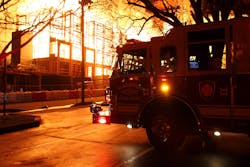On March 16, 2017, Raleigh, NC, firefighters responded to a report of a multiple residential structure fire at 400 West Jones, at the corner of North Harrington Street. Before the last apparatus left the scene 16 hours later, the blaze would result in the displacement of more than 250 people, close busy thoroughfares in the heart of downtown, and be characterized as the largest fire in the capital city for more than a century.
The Metropolitan
The initial dispatch came at 2203 hrs. According to the first caller, “The building that they are building across the street is going up in flames … this is going to be huge.” He was correct on both counts.
The Metropolitan was a 275,000-sq.-ft., five-story apartment complex that spanned a city block. Containing 241 units and of wood-frame construction above a concrete first floor, the Metropolitan was estimated to be approximately 40–50 percent complete. As such, it was topped out, but interior walls were not finished. Fire stopping and sprinklers had yet to be installed.
Initial response
Engines 1, 3, 5 and 13, Ladders 2 and 4, Rescue 1, Battalions 3 and 4, and Deputy Fire Marshal (Car 420) responded to the scene. A Wake County ALS ambulance augmented the response of 31 fire personnel.
While en route, Battalion 3 was advised of multiple calls, and upgraded the status to working fire.
Arriving in less than a minute, Engine 13’s captain assumed command and provided the size-up: “We have a five-story, under construction, residential structure, 155 by 200, heavy fire showing from Division 2.” A second alarm was immediately requested, which assigned Engine 2, Engine 6, Squad 7 (rescue pumper), Ladder 3, Ladder 7 and Battalion 5 to the call. Car 401 (Investigator), Car 20 (Division Chief and Aide) and Air 1 (cascade unit) were added as a result of the working fire designation. EMS resources were also bolstered by the inclusion of five ALS ambulances, an operations support unit, a medic, and four members of the command staff. A staging area was designated at a nearby restaurant.
Mitigating hazards
Radiant heat melted lenses, cracked windows on operating apparatus, and damaged neighborhood electrical distribution systems, which caused a localized power outage, but did not impact firefighting.
Efforts were immediately focused on protecting and evacuating exposures. These exposures included office, mixed-use and residential occupancies, one of which was a high-rise. The third-arriving engine was instructed to begin this process because, in the words of the incident commander, “We’re not going to be able to stop this.”
This assignment was immediately followed by a third alarm request, and this update by the captain of the lead engine: “We have an all-wood construction complex. There is no fire protection in place, and I have fire walking from one end of the block to the next.”
Master streams were already in operation as Engine 11, Engine 20, and Squad 14 (rescue pumper) responded. Less than six minutes had elapsed from the initial dispatch. Four minutes later, the fourth alarm brought Engine 8, 9, and 12.
At the same time, a 100-foot-tall construction crane collapsed from the heat. Although identified as a safety hazard early on, it landed on an exposure without causing injury, and posed no further danger to crews. (It was removed quickly after the event, as the building on which it rested housed telecommunications equipment critical to the region.)
Significant and rapid fire propagation continued, with flames from the main body reaching 200 feet in the air. Controllers at the Raleigh-Durham International Airport, nearly 20 miles distant, initially believed there was some sort of lightshow in progress downtown.
Firefighters on the scene found it difficult to talk over the noise, even when in close proximity to each other. Falling glass also proved problematic.
A fifth alarm at 2232 hrs saw Engines 15, 26, and 27 responding, along with three additional ALS ambulances and another EMS district chief. While this was the final alarm transmitted, it was far from the end of resource assignment. Ladder 8 and Air 2 were special called to the scene, as were Training Engines 1 and 2 and the training academy bus. Two buses were also provided by Capital Area Transit for rehab and evacuation purposes, and the mobile ambulance bus (EVAC 1) was staged at the Public Safety Center.
Raleigh Reserve Engines 106 and 221, as well as Reserve Ladders 111 and 125 were activated, and mutual aid called to cover vacated stations. Apparatus from Apex, Bay Leaf, Cary, Durham Highway, Eastern Wake, Fairview, Garner, Holly Springs, Rolesville, Stony Hill, Swift Creek, Wake Forest, Wendell, Western Wake and Zebulon backfilled for working companies.
All 15 departments have interoperable radio communications with each other and with the City of Raleigh. Multiple tactical channels were utilized on scene to coordinate suppression, staging, and EMS. Among these were one frequency assigned to the communications center for the purposes of status-keeping and another used for operations at the Quorum Center, one of the occupied exposures.
While the fire protection system had not yet been installed in the Metropolitan, the operational systems in exposures were put to good use. Radiant heat that caused apartment windows to completely fail also activated sprinklers. According to Chief John McGrath, who responded from home to assume command, these features were instrumental in reducing the damage. “The safety systems worked,” he said. “The sprinklers helped hold the fire from spreading. While some people might have had some wet and ruined belongings, a cataclysmic event was prevented.”
Standpipes and hose packs were deployed in two adjoining high-rises, and used to combat burning construction materials on an adjacent parking deck. Lines were not charged in the apartments. Instead, debris was relocated under operating heads for extinguishment. A special-called ladder truck was used to feed those in the garage. Elsewhere, 13 master streams, both conventional and elevated, were positioned to surround the blaze.
All told, 24 engines, 7 ladders, 1 rescue, and 2 air units operated at the scene, staffed by 130 firefighters. Water was supplied by 10 different hydrants. Despite these efforts, more than 37 condominiums, 205 apartments, and 10 buildings were damaged. Three more downtown structures, including the Sacred Heart Cathedral and First Baptist Church, reported fires started by falling embers. Four special assignments were used to address incidents relating to the initial call.
This coordinated response pointed out the value in mutual-aid planning even for large cities. During the duration of this event, neighboring communities at one time or another assisted in protecting areas covered by 19 different Raleigh stations.
After the fire
At a follow-up press conference, McGrath explained that the initial priority was to, “Cut the fire off, and that’s what our companies did.” In subsequent interviews with Firehouse, he had high praise for his firefighters, saying that they “played like they trained.”
“This fire presented a unique challenge in that it was at the center of a dense population, and could have spread further,” McGrath said. “The companies provided a good size-up, and the commanders recognized what they had and called for help.” He added, “We were very fortunate in that the construction crane came down without incident. In retrospect, we might have sounded the ‘all clear’ a little earlier when we confirmed that fact.”
When asked about the logistics of ensuring safety during such large events, he offered, “Realistically, I don’t think anyone ever has complete accountability on the fireground, but there was no freelancing. We used the Incident Command System, personal accountability tags, and did the things that we do every day on every call, scaled upward for this event.”
As a veteran of the Philadelphia Fire Department, McGrath has seen larger fires, but this was the most significant blaze he has encountered during his 11 years in Raleigh. His largest previous incident since moving south came in February 2007, when 38 homes were destroyed or damaged by a wind-whipped fire at the Pine Knoll Townes Subdivision. (See Carolina Burning in the July 2007 issue of Firehouse.)
When asked to compare the two incidents he responded, “In the first case, we had high winds and a completely different setting. Since the second fire was in a downtown urban area, we were fortunate that winds were not a factor.” Conditions in Raleigh that evening were 35 degrees, clear skies and calm winds, with the thermometer dipping into the 20s by morning. Just two nights before, gusts up to 41 mph had been recorded.
In the days that followed, the City of Raleigh established assembly areas and provided transportation for residents seeking to remove items from their damaged homes. As of this writing, local, state and federal investigators have not released a cause of the fire. The loss of the building itself is estimated at $12 million, with additional costs for damaged exposures, contents, and economic impact.
The fire also ignited a debate about building codes that allow for the use of wood-frame construction in multiple dwellings. Opponents point out the magnitude of the blaze, fueled by literally tons of lumber. Supporters counter that in a finished state, such structures are inherently safer than when partially complete, and that the same codes in question specify sprinkler systems that played a significant role in preventing fire spread.
“A career-defining moment”
Many who responded to this incident have deemed it “a career-defining moment.” It will long be remembered by both firefighters and a grateful community, whose outpouring of support ranged from children’s cards and letters to formal recognition by the State Legislature. While March 17 typically marks the observation of St. Patrick’s Day in many establishments in downtown Raleigh, this year, it took on new meaning as people celebrated the skill of Raleigh’s firefighters in addition to the luck of the Irish.
About the Author

Barry Furey
BARRY FUREY, who is a Firehouse Contributing Editor, provides consulting and training services in emergency communications. He is the former director of the Raleigh-Wake Emergency Communications Center in North Carolina. During his 50-year public safety career, he has managed 9-1-1 centers and served as a volunteer fire officer in three other states. In 2005, Furey received a life membership in the Association of Public-Safety Communications Officials (APCO) International for his continued work in emergency communications. Furey was inducted into the Firehouse Hall of Fame in 2017.
